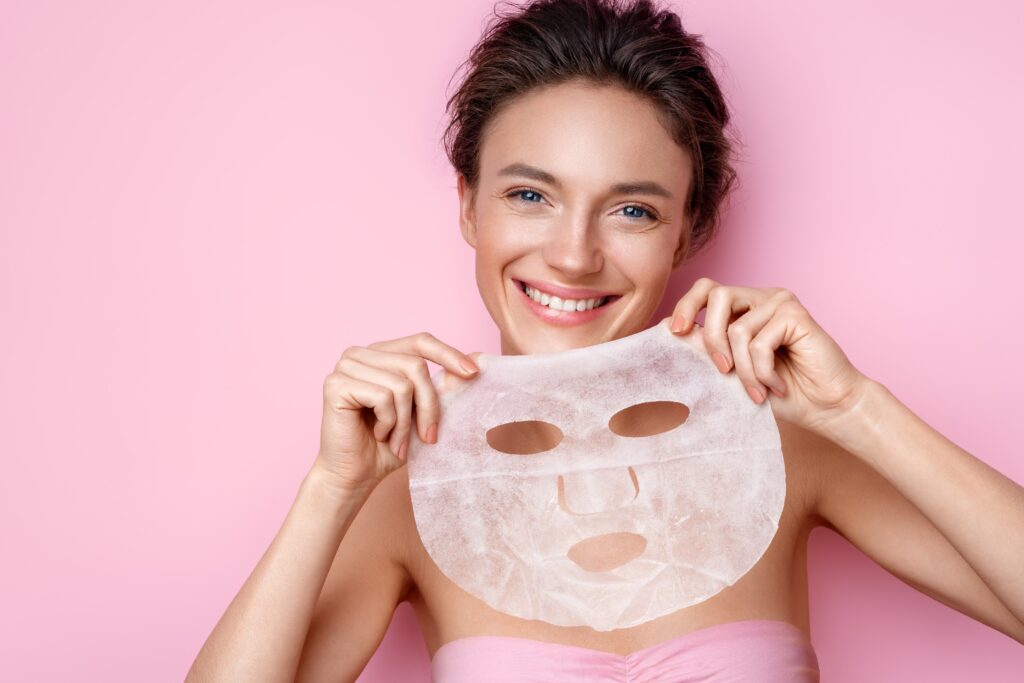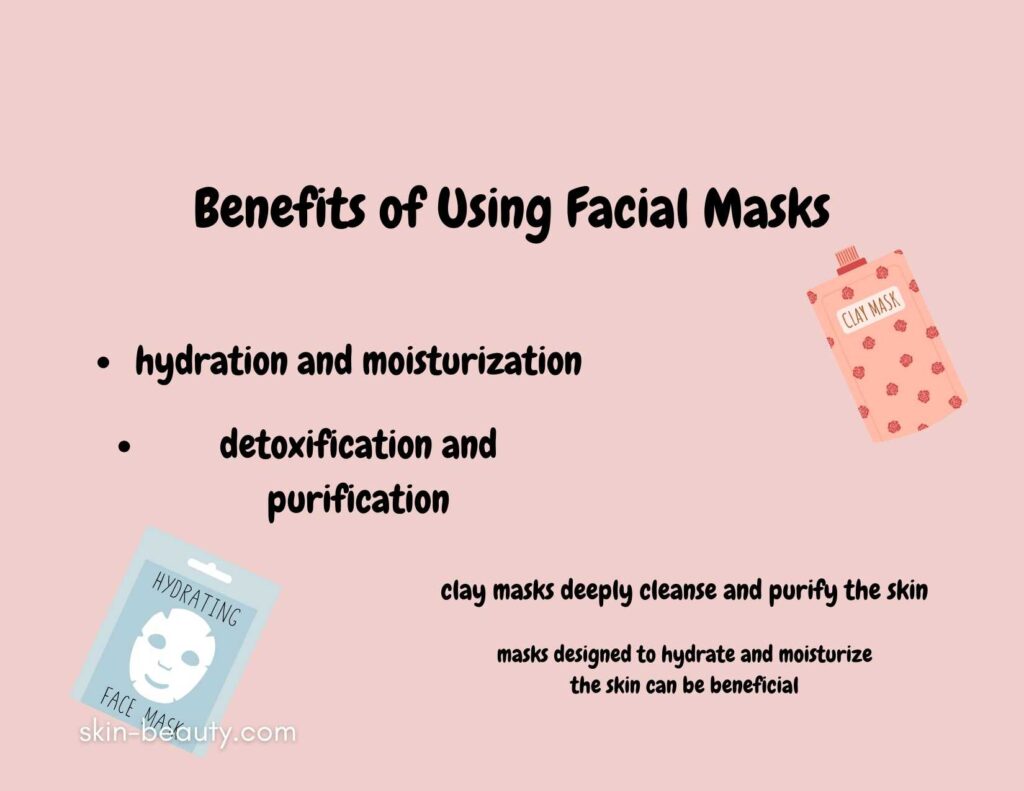
Facial masks are intensive skincare treatments that deeply hydrate, detoxify pores, repair the skin barrier, and enhance radiance. By delivering concentrated active ingredients, they target specific concerns such as dryness, acne, dullness, sensitivity, and aging to improve texture and overall skin health.
Key Takeaways
- Clay and charcoal masks absorb oil, detoxify pores, and reduce acne.
- Sheet and biocellulose masks provide instant hydration and soothe dryness.
- Cream and gel masks nourish and calm sensitive or dry skin.
- Peel-off and exfoliating masks remove dead cells for smoother texture.
- Overnight and LED masks repair skin, stimulate collagen, and reduce inflammation.
- Key actives: clay, hyaluronic acid, vitamin C, niacinamide, biocellulose, and red light therapy.
- Choose masks by skin type and concern; follow up with moisturizer and sunscreen.
Why Masks Matter for Skin Health

Masks play multiple roles by deeply hydrating skin, repairing the skin barrier, improving texture, and enhancing radiance. They help replenish moisture, soothe irritation, and prepare skin to better absorb serums and sunscreens. By providing targeted care—whether calming redness or controlling oil masks support your overall skin health.
- Masks provide deep hydration that helps maintain and restore the skin’s moisture balance, crucial for a healthy skin barrier.
- They offer intensive cleansing by drawing out impurities and excess oils from deep within pores, which regular washing may not achieve.
- Masks help unclog pores, reducing the likelihood of acne and breakouts by removing dirt, oil, and dead skin cells.
- Many masks promote skin barrier repair, strengthening the skin’s natural defenses against environmental stressors and pollution.
- Using masks can improve skin texture, making it smoother and more refined by aiding exfoliation and cell renewal.
- Masks stimulate blood circulation, resulting in a refreshed complexion with enhanced glow and radiance.
- They enhance the effectiveness of other skincare products by preparing the skin to absorb serums, moisturizers, and sunscreen better.
- Masks can calm and soothe irritation, especially formulations with hydrating and calming ingredients like aloe or oatmeal.
- Regular use supports skin detoxification, helping remove pollutants and impurities accumulated on the skin surface.
- Masks also contribute to a relaxing self-care ritual, which promotes overall wellbeing alongside skin benefits.
Types of Facial Masks for Glowing Skin & Their Functions
Face masks come in various types, each designed to address specific skin concerns and provide targeted benefits. Understanding the functions of different masks helps you choose the right one for your skin’s needs. Here are the common types of masks and their primary functions.
- Clay/Charcoal Masks: Absorb excess oil, detoxify pores, and reduce acne by drawing impurities out. Ideal for oily and acne-prone skin, especially for teenagers with breakouts.
- Sheet Masks: Pre-soaked in serums, these provide instant hydration, are convenient, and help soothe sensitive or dry skin.
- Cream/Gel Masks: Rich in moisturizing and calming ingredients, suitable for dry or sensitive skin needing gentle nourishment.
- Peel-off Masks: Exfoliate dead skin cells and impurities, promoting brighter skin texture.
- Overnight/Sleeping Masks: Provide deep hydration and skin repair over several hours, supporting skin renewal during sleep.
- LED/Tech Masks: Use light therapy (e.g., red light) to stimulate collagen production and reduce inflammation.
Choosing Masks Smartly by Skin Concern
Selecting the right face mask tailored to your specific skin concerns ensures optimal results and keeps your skin healthy and balanced. Different skin types and issues require distinct ingredients and formulations to address their unique needs effectively.

- Dry or Dehydrated Skin: Choose masks enriched with hydrating ingredients such as hyaluronic acid and ceramides. Gel or cream-based masks provide deep moisture, soothe dryness, and strengthen the skin barrier for long-lasting hydration.
- Oily and Acne-Prone Skin: Clay and charcoal masks are excellent for these skin types as they absorb excess oil and impurities from pores. Masks containing salicylic acid help reduce acne and prevent future breakouts by exfoliating and unclogging pores.
- Sensitive or Redness-Prone Skin: best for soothing sheet masks or cream masks with calming ingredients like oatmeal, aloe vera, chamomile, and other botanicals. These masks help reduce irritation and strengthen sensitive skin without causing further stress.
- Aging or Dull Skin: Masks with peptides, vitamin C, and antioxidants support collagen production,complementary to retinol treatments, brighten the complexion, and reduce fine lines and wrinkles. Overnight or sleeping masks infused with these ingredients allow continuous skin nourishment through the night.
- Combination or Multiple Skin Concerns: Multi-masking is a smart approach where you apply different masks on various facial zones based on their specific needs such as a hydrating mask on dry cheeks and a clay mask on oily T-zone areas.
Active Ingredients That Work; With Evidence
Various active ingredients in face masks have been scientifically proven to deliver real benefits for different skin concerns. These ingredients play key roles in improving hydration, texture, firmness, and overall skin health. Here is a summary of some of the most effective active ingredients found in masks, along with evidence supporting their effects:
- Clay: Clay masks are excellent for oily and acne-prone skin because they absorb excess sebum and impurities from deep within pores. Clinical studies show they improve sebum control, increase skin hydration, and refine texture, helping reduce shine and breakouts.
- Biocellulose: Biocellulose masks are made from natural fibers that conform closely to the skin’s surface. Research indicates they promote skin hydration, reduce roughness and wrinkles by aiding collagen synthesis, and support long-lasting moisture retention.
- LED Red Light Therapy: LED masks using red light have been proven to stimulate collagen production, boost circulation, and calm inflammation. These effects contribute to improved skin firmness, reduced redness, and faster healing of skin damage.
- Hyaluronic Acid: Known for its moisture-binding properties, hyaluronic acid attracts and retains water in the skin, providing deep hydration and plumping effects. It helps reduce dryness and fine lines by maintaining skin elasticity and improving softness.
- Vitamin C and Niacinamide: Both are potent antioxidants that brighten the skin by inhibiting melanin production and reducing pigmentation. They also protect against environmental stressors like pollution and UV rays, improving overall radiance and evenness of skin tone.
Trending Masks & Why They Stand Out
Several face masks have gained notable popularity recently due to their unique formulations, visible benefits, and social media buzz. These trending masks offer targeted solutions that combine effective ingredients with innovative delivery systems, making them stand out in the crowded skincare market.
- Biodance Bio-Collagen Real Deep Mask: Viral for intense hydration and a natural glow on platforms like TikTok.
- Neuraé Harmonie Sleeping Mask: Combines sleep benefits with skin hydration for overnight rejuvenation.
- 111Skin Mix & Mask: Offers customizable luxury skincare solutions for tailored needs.
- Drugstore Favorites: Products like Neutrogena Hydro Boost offer accessible and effective hydration widely praised in reviews.
Best Practices for Use
Using face masks effectively requires understanding how often and when to use them, how to apply them properly, and how to integrate them into your overall skincare routine to maximize benefits while minimizing risks. Here are the key best practices:
- Avoid common skincare mistakes such as over-exfoliating with masks.
- Introduce masks gradually, especially strong clay or peel-off types.
- Always patch test before applying new formulations.
- Men can also benefit from masks as part of balanced skin care routines.
- For sensitive hormonal phases, opt for gentle masks that balance skin changes caused by hormones.
- Choose between natural vs synthetic formulations based on your preference and tolerance..
Myths & Misconceptions
Face masks are popular skincare boosters, yet several myths and misunderstandings surround their use. Clearing these up helps you use masks effectively and safely.
- Masks Are Not a Substitute for Sunscreen or Moisturizer
Masks provide targeted treatment like hydration or exfoliation but do not replace the essential daily use of sunscreen and moisturizer to protect and maintain skin health. - Price Doesn’t Always Equal Performance
Expensive masks aren’t always better. The formulation and ingredients matter more than price. Many affordable masks deliver excellent benefits. - Over-Exfoliation Risks
Using exfoliating or peel-off masks too frequently can cause irritation, redness, and damage to the skin barrier. Follow product directions and avoid daily use of strong masks. - LED Masks Are Safe When Used Properly
Contrary to some fears, LED light therapy masks are not harmful if used according to instructions. They can safely boost collagen and reduce inflammation. - Masks Provide Temporary Benefits
Many mask effects, like hydration or glow, may be temporary. Regular and consistent use integrated into a balanced skincare routine yields better long-term results.
Conclusion
Facial masks enhance skincare by deeply hydrating, unclogging pores, repairing the skin barrier, and improving texture and glow. With varieties like clay, sheet, cream, peel-off, overnight, and LED masks, each targets specific needs from oil control to anti-aging. Key proven ingredients include clay for sebum control, biocellulose for hydration, hyaluronic acid for plumping, vitamin C and niacinamide for brightening, and LED red light for collagen stimulation.
Selecting masks suited to your skin type dry, oily, sensitive, aging, or combination ensures the best results. Use consistently, patch test, try multi-masking, and follow with moisturizer and sunscreen for healthy, radiant skin.
FAQs
How often should I use a face mask?
Use treatment masks like clay or exfoliating masks about once a week to avoid irritation. Hydrating masks can be used more frequently, even daily, depending on your skin’s needs.
Can I use different masks on different parts of my face?
Yes, multi-masking is recommended to address different skin concerns in various areas, for example, a clay mask on oily T-zone and a hydrating mask on dry cheeks.
What ingredients should I look for in a mask for dry skin?
Look for hydrating ingredients like hyaluronic acid, ceramides, aloe vera, and glycerin to provide moisture and strengthen the skin barrier.
Are clay masks suitable for sensitive skin?
Clay masks are generally more suited for oily or acne-prone skin. Those with sensitive skin should use clay masks cautiously or choose gentler formulations and always patch test first.
How do LED masks work and are they safe?
LED masks use light therapy (such as red light) to stimulate collagen production, reduce inflammation, and promote healing. They are safe when used according to instructions.
Can I use face masks daily?
Hydrating sheet or cream masks can be used daily, but exfoliating or detoxifying masks should be limited to avoid overuse and irritation.
Do natural DIY masks work as well as commercial ones?
Natural DIY masks with ingredients like honey, aloe, or olive oil can provide benefits and be gentle, but they may lack the potency and targeted actives found in well-formulated commercial masks.
How long should I leave a face mask on?
Follow product instructions, typically 10–20 minutes for most masks. Over-leaving a mask can cause dryness or irritation, especially with exfoliating formulas.
What should I do if I experience irritation after masking?
Stop using the mask, soothe your skin with a gentle moisturizer or aloe vera, avoid other active ingredients temporarily, and consult a dermatologist if irritation persists.
Can face masks replace moisturizer or sunscreen?
No. Masks provide specific treatments but do not replace the daily essential steps of moisturizing and sun protection which are critical for overall skin health.
Reference
- Facial masks deeply hydrate the skin, repair the skin barrier, improve texture, and enhance radiance by delivering concentrated active ingredients for targeted skin concerns(https://www.healthline.com/health/beauty-skin-care/do-face-masks-work).[1]
- Clay and charcoal masks absorb excess oil, detoxify pores, and reduce acne, making them ideal for oily and acne-prone skin(https://www.healthline.com/health/clay-mask-benefits),(https://www.healthline.com/health/charcoal-mask-benefits).[2]
- Sheet masks offer instant hydration and soothe sensitive or dry skin, providing convenient delivery of serums(https://www.ulta.com/shop/skin-care/treatment-serums/face-masks?mask+type=sheet_mask).[4]
- Cream and gel masks calm and moisturize dry or sensitive skin gently(https://www.ulta.com/shop/skin-care/treatment-serums/face-masks?mask+type=sheet_mask).[4]
- Peel-off masks exfoliate dead skin cells and impurities to promote brighter texture(https://www.healthline.com/health/beauty-skin-care/do-face-masks-work).[1]
- Overnight or sleeping masks provide deep hydration and allow prolonged skin repair during sleep(https://www.healthline.com/health/sleeping-with-face-mask).[5]
- LED masks use red light therapy to stimulate collagen production, reduce inflammation, and promote skin healing safely(https://www.healthline.com/health/beauty-skin-care/do-face-masks-work),(https://www.healthline.com/health/charcoal-mask-benefits).[3]
- Key active ingredients backed by research include clay for oil control and sebum absorption(https://www.healthline.com/health/clay-mask-benefits), biocellulose for hydration and wrinkle reduction(https://pmc.ncbi.nlm.nih.gov/articles/PMC7027794/), hyaluronic acid for intense moisture retention, vitamin C and niacinamide for brightening and antioxidant protection(https://www.healthline.com/health/beauty-skin-care/do-face-masks-work).[6]
- Choosing masks tailored to skin concerns—hydrating masks for dry skin, clay masks for oily skin, soothing masks for sensitive skin—ensures targeted benefits and healthier skin(https://www.ulta.com/shop/skin-care/treatment-serums/face-masks?mask+type=sheet_mask).[4]
Dr. Amiah Rainey researches diet–disease relationships with expertise in vitamins, minerals, and biomarker methods. She earned a PhD from Harvard T.H. Chan School of Public Health (2019) and completed a postdoctoral fellowship at the NIH/NIDDK. With ~20 peer-reviewed publications (example) and experience on NIH-funded cohort studies, Amiah translates complex evidence into practical guidance. She advises on study design, evidence grading, and data transparency. Profiles: ORCID, Google Scholar; list affiliations and any disclosures.

